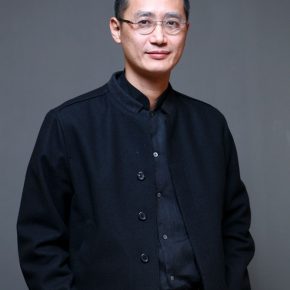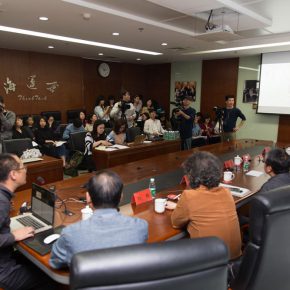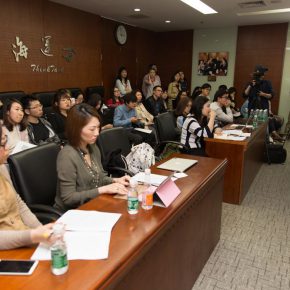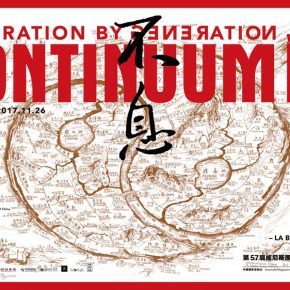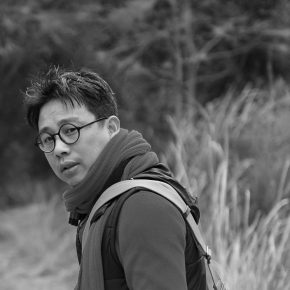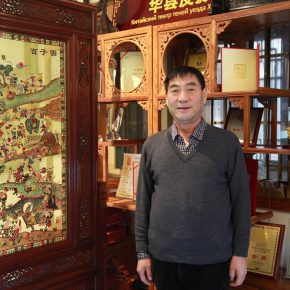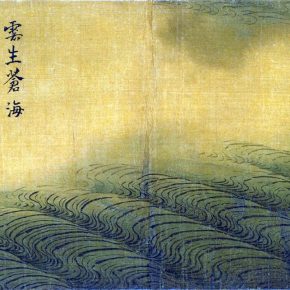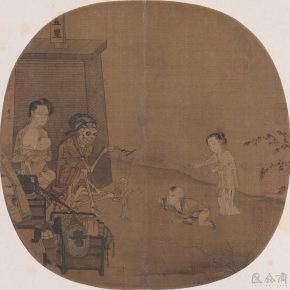
On April 19, 2017, the China Pavilion at the 57th Venice Biennale launched a press conference in Beijing revealing the concept and connotation of the theme of the exhibition “Continuum”, artists’ programs, exhibition design, etc. for the media and the public. The China Pavilion at the 57th Venice Biennale is supported by the Ministry of Culture of the People’s Republic of China, organized by China Arts & Entertainment Group (CAEG), Shanghai Ming Contemporary Art Museum and Beijing Times Art Museum. The exhibition will be held on May 11, 2017, going through to November 26, 2017.
The chief theme of the current Biennale is “Viva Arte Viva”, which aims to become a biennial “designed by artists in cooperation with artists for artists”, and to explore the undiscovered or forgotten art. The expert committee eventually selected Qiu Zhijie, Dean of the School of Experimental Art, the Central Academy of Fine Arts and a well-known artist at home and abroad, to act as the curator of the “Continuum” for the China Pavilion at the 57th Venice Biennale. This is also an exhibition organized by “an artist for artists”, proposing Chinese programs with the thoughts of what “immortality” is, showcasing the profound connotation of Chinese wisdom, explaining the mystery of the immortality of Chinese culture and Chinese art, in the form of positive interactions between contemporary art and folk art. Participating artists include Tang Nannan, Wu Jian’an, Wang Tianwen and Yao Huifen, and the first two artists are contemporary artists with an academic background, while the latter two have inherited the Intangible Cultural Heritage.
At the press conference, curator Qiu Zhijie explained in detail curatorial ideas and programs of the exhibition. It uses the “Mountain and Ocean” and? “Ancient and Modern”, which are two interchangeable constructions of “Yin ? Yang” to unfold the narration, the use of two well-known stories of “The Foolish Old Man, who removed the mountains with his family” and “The Mythical Bird Jingwei who tried to fill up the sea with pebbles” to form an? image corresponding to “mountain” and “ocean”, the use of two paintings of the Song Dynasty including Li Song’s “Skeleton Fantasy Show” and Ma Yuan’s “Twelve Images of Water Surging” constitute the citation of the exhibition, the unique Chinese spiritual world constitutes the image that directs to the “Continuum.” Tang Nannan, a contemporary Chinese artist who has drawn energy from the ocean and Wu Jian’an, a contemporary Chinese artist who has drawn from the energy of superstition; Wang Tianwen, a master of folk arts and crafts who carves shadow puppets and Yao Huifen, a master of folk arts and crafts who brings together the inherited contexts of Suzhou embroidery, they all started a cooperation on the two stories and the two paintings of the Song Dynasty one thousand years ago which injects more vitaliity and possibilities to the exhibition space.
“Cooperation” and “heritage” are the basic connotation and the spiritual field for this exhibition. Yao Huifen will reproduce the “Skeleton Fantasy Show” using one hundred stitches from Suzhou embroidery, and also participates in the Tang Nannan’s creation of “Oblivious Ocean 7”. Wu Jian’an and the master of shadow puppets, Wang Tianwen have been cooperating for many years and intend to start a new creation on Ma Yuan’s “Water Figure” and images of mountains and ocean. Tang Nannan who was born into a theatrical family and the master of shadow puppet Wang Tianwen, Wu Jian’an who came from Jinshan in Shanghai and Yao Huifen from Suzhou, will also cooperate and produce new works. Folk crafts and the creation by contemporary artists mutually permeate each other in the continuous reconstruction and rebirth of Chinese art, they have formed an intertextual collectivity, and there are the interactions between one point and multiple points, multiple points and multiple points, and each artist is also in cooperation with the other three artists; at the same time, the curator and artists will also cooperate to form a live performance. In this exhibition, all the artists won’t independently display their creations, but give a response and a start, looking forward to responses and being able to always add annotations and inscriptions. Chinese art is a centurial collective creation, while the artist is a creative individual that is constantly involves in it.
In contrast to the previous China Pavilions, it specifically establishes a document area, to showcase the respective artists’ apprenticeship, further implemention of the image and field of “continuum” to offer evidence of the documents. We will see the clear contexts of the artists’ apprenticeship in the exhibition: Wu Jian’an – Lv Shengzhong – Yang Xianrang and Feng Zhen – Xu Beihong and Moiseyenko … Wang Tianwen – Li Zhanwen – Li Sanxi ... Tang Nannan – Xu Li – Lin Yiyou and Xie Yijia, and Ni Yide and Hu Shanyu were Lin Yiyou’s teachers, while Huang Binhong and Lin Fengmian were Xie Yijia’s teachers… Yao Huifen – Mou Zhihong – Jin Jingfen – Shen Shou, and Yao Huifen – Ren Huixian – Yang Shouyu – Lv Fengzi – Li Ruiqing ... In this overlapping response between the elegance and vulgarity, the old and new, generation by generation, with the form of the endless relay, the exhibition gathers a continuum energy field, which is completely different from the art production mode emphasizing personal creation, but it is the secretary of the circle of life of Chinese art and Chinese civilization for thousands of years.
The exhibition will last for six months. The audience will travel from the ancient to the modern with the diverse forms of exhibition and performance covering painting, video, installation, sculpture, performance, photography and Suzhou embroidery, shadow puppets and the exhibition will also use a multimedia shadow play, shadow puppet workshop, as well as the public creative activities including “Venice” and “Story of Looking for the Ocean” of the “Global Beach Archaeological Plan”, it constantly enriches and updates the viewer’s multi-dimensional experience. After the end of the exhibition in Venice, it will move back to China and continue to be on show in many cities.
About the Curator????
Qiu Zhijie was born in?Fujian?province in 1969. In 1992, he graduated from the Department of Printmaking at?Zhejiang Academy of Fine Arts,?Hangzhou. Qiu is currently Dean of the School of Experimental Art, CAFA, and a professor. He is a professor at the SIMA at the China Academy of Art, tutor of master and doctor students. He was one of the artists participating in the China Pavilion at the 2009 Venice Biennale, and participated in the Thematic Pavilion of 2015 Venice Biennale. He also attended Sao Paulo Art Biennial in 2002 and 2013, and various international biennials. As a curator he planned the first video art exhibition in China in 1996, in addition to planning a series of exhibitions entitled “Post-Sense Sensibility” to promote the young artists from 1999 and 2005. In 2003 he planned the first exhibition in the 798 Art District. In 2012 he was the chief curator of the “Reactivation” the 9th Shanghai Biennale.
About the Artists
Wang Tianwen is a successor of shadow puppets in Shaanxi, he learned from Li Zhanwen, a master of the arts and crafts in China and the famous shadow puppet carving artist. Wang is called the 5th Master of the Arts and Crafts in China, an appraisal expert of Chinese shadow art carving, and the first-class master of the arts and crafts in Shaanxi Province. In 1982, Wang was invited to be responsible for the design for the National Museum of Japanese History, and engraved a full set of “Monkey Makes Havoc in Heaven”, which was praised by Japanese friends; in 1983 he designed and produced the shadow figures of the “Fan Lihua Split Yang Fan with Her Knife”, he won the “Gold Award” for excellent design for tourism products by the Ministry of Light Industry of the People’s Republic of China; in 1984 he engraved the shadow puppet figures of the “Royal Progress Figure”, which won the “Gold Award” of outstanding product design in Shaanxi Province, in the same year he won the “Hundred Flowers Award” of the Xi’an tourism products; in 2000, the work “Foreign General” won the Excellence Creation Award at the First China Arts and Crafts Works & the Arts and Crafts Collections Fair; in 2008, he created the “White Snake”, which won the Silver Award at “China Arts and Crafts Cultural and Creative Award” by the 4th China International Cultural Industry Fair.
Tang Nannan was born in Yunxiao, Fujian Province in 1969. He received a Master’s degree from the School of Arts, Xiamen University, and received a doctoral degree from the SIMA, China Academy of Art. He is a teacher of the SIMA, the China Academy of Art, living and working in Hangzhou. The works start from nostalgia to form a discussion on time and memories, mythologies and poetry, nostalgia and life and death, etc. Trying to take the cultural study on sociology as the basis, considering the ocean and flowing water as the images, he then explores the fusion and mutual inspection of a variety of art forms including painting, installation, photography, animation and multi-screen video theater, to find the inspiration from personal life experience and is concerned about the possibilities of contemporary life.
Yao Huifen was born in an embroidery family in Suzhou, and started learning embroidery in her childhood. Yao learned from Mou Zhihong, the third generation of Shen Shou, the master of “Simulation Embroidery” of the Suzhou embroidery and Ren Huixian, master of the Chinese arts and crafts. She is good at perfectly blending techniques of crewel embroidery within traditional Chinese ink painting, so that the embroideries are more original. She is a national senior craft artist, who won the titles of “Arts and Crafts Celebrity in Jiangsu Province” and “Young Expert with Outstanding Contributions in Jiangsu Province”. Her works won the Gold Award from the “China National Arts and Crafts Master Exhibition” for three consecutive years. The selected representative works are “Zhang Daqian’s Portrait”, “Splash-Color Red Lotus Figure”, “Rhyme of Lotus”, and so on.
Wu Jian’an was born in Beijing, and his ancestral home is Jinshan in Shanghai. He graduated from the Department of Advertising, Beijing Broadcasting Institute, received a bachelor’s degree. After he graduated from the Central Academy of Fine Arts, he received a master’s degree, Wu continues to remain on the school staff. He is an Associate Professor of the School of Experimental Art, the Central Academy of Fine Arts, living and working in Beijing.
Text edited by Zhang Wenzhi, translated by Chen Peihua and edited by Sue/CAFA ART INFO
Photo by Yang Yanyuan/CAFA ART INFO
Images courtesy of the organizer??


